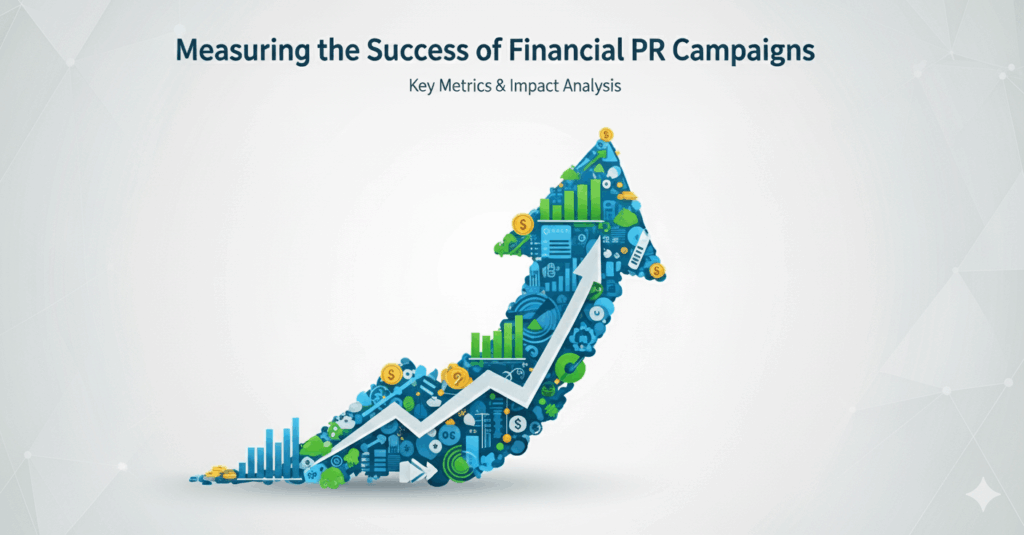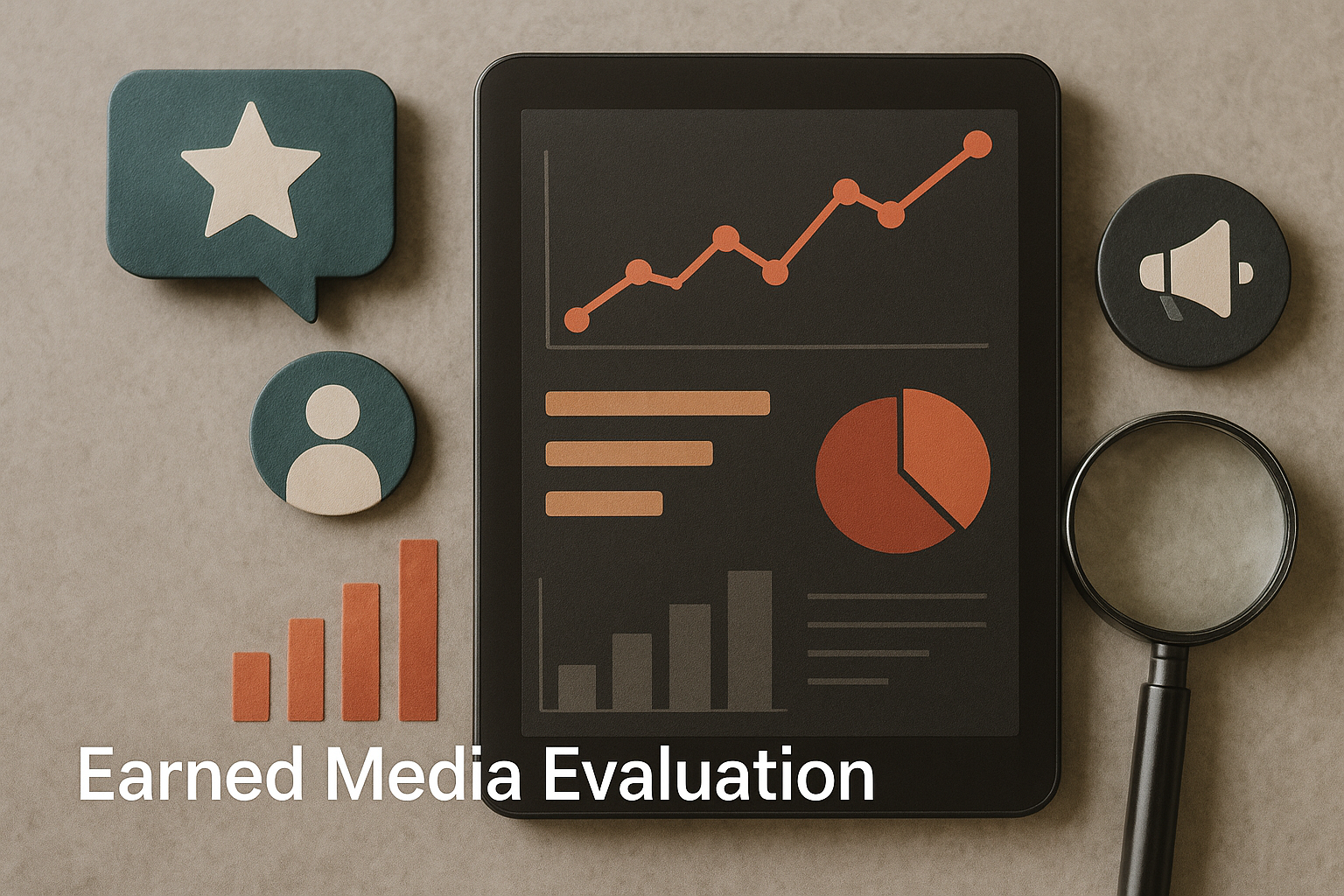Here’s your complete guide to financial public relations.
You might think money talks on its own. But it doesn’t. Numbers don’t tell the whole story. Behind every report, every merger, every market move, there’s something that needs explaining. That’s where financial public relations steps in.
It’s like a bridge. Between the company, the investors, and the public. Turning messy data into stories people actually get. Stories they can trust. It makes sure the right voices get heard when things matter most. And it keeps credibility intact when the market wobbles.
These days, trust can vanish fast. One headline, one rumor, and shares can jump or drop. Financial PR, as part of larger corporate branding services, isn’t just about hype. It’s about balance, clarity, and confidence. Do it right, and you get attention for the right reasons. You keep your investors and your audience on your side.
What Is Financial Public Relations?

It sounds fancy, but at its core, financial public relations is about trust. It’s really about turning numbers and reports into something people can actually follow. Not just the analysts with spreadsheets open, but regular folks too.
Companies love to talk about balance sheets, investors chase growth charts, but if nobody explains it clearly, all you get is confusion. And when the message isn’t clear, everyone’s just guessing. And guessing is dangerous in the world of money.
Beyond Traditional PR
Normal PR might focus on product launches, social buzz, or brand reputation. Financial PR digs deeper. It works with earnings announcements, mergers, IPOs, or even market rumors. The aim isn’t just to get headlines it’s to get the right headlines. Because when money is on the line, perception can change everything.
The Story Behind the Numbers
Financial public relations turns raw data into a story. Quarterly results, for example, are more than just percentages and figures. They show how a company is growing, where it’s struggling, and what comes next. Good PR makes sure that story reaches investors, journalists, and the market in a way that builds confidence instead of confusion.
Startups chasing funding. Public companies protect share prices. Banks, asset managers, even governments. Anyone dealing with money and public trust benefits from financial PR. It’s not just for giants listed on stock exchanges. Smaller businesses, too, need it to prove they’re stable, transparent, and worth backing.
Why It Matters
Markets move fast. News spreads faster. A single mistake in communication can rattle investors and sink credibility. That’s why financial PR is more than just press releases. It’s about strategy, timing, and knowing how to talk when the pressure is on. Done right, it keeps confidence steady, even when markets aren’t.
The Bigger Picture
At the end of the day, financial public relations is about balance. It’s where clarity meets strategy. It’s making sure people don’t just see numbers, but understand the meaning behind them. And when investors, journalists, and the public all walk away with trust intact that’s when financial PR proves its real value.
Investor Relations Communication

Investors don’t just want numbers, they want context. They want to know why a company is growing, or why profits dipped. That’s where investor relations communication steps in. It’s the part of financial public relations that builds a steady bridge between a company and its backers.
More Than Just Reports
Annual reports, quarterly updates, investor calls. They’re all important, but they’re not enough on their own. Communication here isn’t about stacking pages of figures. It’s about giving clarity. It’s making sure the story behind those figures is simple, honest, and easy to follow. Because investors aren’t just looking at results they’re deciding whether to keep their trust.
Building Confidence
Markets rise and fall. But if communication is strong, investors feel steadier. A clear update can calm nerves during a rough quarter. A transparent strategy can spark excitement for the future. In the end, confidence is the real currency. And companies earn it by speaking openly and often.
Honesty Over Hype
It’s tempting to spin only the positives. But investors are smart. They see through the gloss. The best investor relations teams don’t hide the rough spots they explain them. They show how challenges are being tackled, what’s being fixed, and what the plan looks like ahead. That honesty doesn’t weaken trust. It strengthens it.
The Human Side of Finance
Numbers matter, but people remember how those numbers are delivered. A CEO’s tone in an earnings call. The clarity of a presentation. Even the timing of an email update. All of it shapes perception. And in a world where capital can move with a click, perception can be the difference between support and skepticism.
Where It Fits in Financial PR
Investor relations communication isn’t separate, it’s the backbone of financial public relations. It ensures that investors stay informed, journalists get accurate context, and the wider market feels stable. Without it, financial PR loses its edge. With it, companies keep trust alive through both good times and tough moments.
Financial Media Coverage

Headlines move markets. One story can boost a company’s reputation overnight. Another can spark panic just as fast. That’s why financial media coverage is such a critical piece of financial public relations. It’s not only about being seen it’s about being seen in the right way.
Why Media Matters
Investors read news before they make decisions. Journalists shape how the public interprets numbers, deals, or leadership changes. A single feature in the Financial Times or Bloomberg can carry more weight than weeks of advertising. The reason? People believe in independent voices. And when the right voices tell your story, credibility rises.
Crafting the Message
But the media doesn’t chase every story. It looks for relevance, clarity, and impact. That’s where PR teams step in. They take complex financial updates, earnings reports, mergers, IPO announcements and turn them into clear, compelling narratives. Numbers stay accurate, but the language becomes digestible. In other words, it’s not just reporting data. It’s shaping perception.
Relationships That Count
Financial media isn’t a one-time pitch. It’s really about building lasting connections with journalists and editors. The brands that stay open and consistent in their communication usually get noticed when it counts. Trust isn’t one-sided. When reporters see a company being upfront, they’re far more willing to share its perspective even when the news isn’t pretty.
Handling the Tough Days
Good coverage feels easy when times are good. But the real test shows up during downturns. Market dips, lawsuits, leadership changes and bad news spreads fast. Smart financial PR doesn’t hide. It shapes the story, adds the facts that matter, and keeps the company’s voice from getting drowned out. Acting early like that can be the difference between a problem that fades and a hit to the brand that sticks around.
The Bigger Role in Financial PR
Media coverage ties everything together. It carries investor updates to the public, translates technical reports into human stories, and ensures transparency reaches beyond boardrooms. Within financial public relations, the media is the loudspeaker. And when used wisely, it turns complex financial reality into clear public understanding.
Financial Press Releases

Press releases don’t scream for attention. They don’t go viral. But in the world of finance, they’re one of the most reliable tools a company has. They tell the market what’s happening, when it’s happening, and why it matters. And when done right, they turn corporate updates into trusted public records.
The Backbone of Communication
Financial press releases are the quiet backbone of financial public relations. Earnings announcements, merger deals, leadership changes, these stories start here. A press release may look straightforward, but it’s the first version of the truth many investors, journalists, and analysts will see. That’s why accuracy and clarity matter more than flair.
What Makes a Good One
The best press releases are simple. They put facts first. Numbers are clear, quotes are sharp, and jargon takes a back seat. Timing also matters. Release news too late, and rumors fill the gap. Release too soon, and key details get missed. The sweet spot is precise, and PR teams know how to find it.
More Than Just Numbers
It’s easy to think a press release is just data. But it’s also about tone. Does it show confidence without arrogance? Does it admit challenges without sounding weak? These small choices affect how the market reacts. Sometimes, a carefully chosen phrase can calm nervous investors or spark new interest.
When It Counts Most
Press releases matter most during big moments. An IPO. A quarterly earnings call. A sudden leadership change. In these times, investors don’t want rumors. They want clarity. They want facts, straight from the source. And a well-structured release gives them exactly that.
Part of the Bigger Picture
On their own, press releases don’t build reputation. But as part of financial public relations, they’re essential. They provide the foundation. The media picks them up, investors reference them, and the public learns from them. Without them, the conversation drifts into speculation. With them, a company controls its story and its credibility.
Crisis Communication in Finance

In finance, calm can vanish in seconds. A rumor spreads, a deal falls apart, or earnings disappoint. Suddenly, trust wavers and confidence slips. When that happens, crisis communication becomes the shield. It’s not about silencing the noise, it’s about guiding it.
Why Crises Hit Harder in Finance
Markets feed on emotion. Fear and optimism move money faster than logic sometimes does. That’s why a single headline can trigger panic selling or wild speculation. In these moments, silence is dangerous. If a company doesn’t speak, someone else will. And their version of the story may not be true.
The Role of Communication
Crisis communication in finance is about speed and clarity. The first statement sets the tone. The market doesn’t expect perfection, but it does expect honesty. Quick updates calm nerves. Clear language replaces uncertainty. And every word counts, because investors are watching closely for signs of strength or weakness.
Honesty as Strategy
It’s tempting to downplay problems. But investors aren’t fooled easily. They’d rather hear tough news directly than discover it later through whispers. That’s where financial public relations proves its value. Strong PR teams admit challenges, explain the impact, and outline next steps. This honesty doesn’t erase the crisis but it keeps trust alive.
Tools That Work
Press releases, media briefings, investor calls are standard tools. But during a crisis, they carry more weight. Timing matters even more. Transparency matters even more. And tone matters most of all. A CEO’s voice in an earnings call can reassure or alarm. A poorly worded statement can either settle markets or spark fresh doubts.
Learning From the Past
History has shown that crises don’t end with the initial shock. They linger. Companies that communicate consistently during tough times recover faster. They rebuild credibility by keeping stakeholders updated, not just once, but throughout the entire storm. On the other hand, those that stay quiet often suffer reputational damage long after the financial hit has passed.
Beyond Containment
Crisis communication isn’t only about putting out fires. It’s about shaping the narrative for the future. By addressing mistakes, showing accountability, and explaining solutions, companies turn setbacks into proof of resilience. Investors may forgive a stumble, but they rarely forgive silence or denial.
The Bigger Picture
In the end, crisis communication in finance is about control. Not control over markets they’ll always swing but control over trust. Done right, it reminds stakeholders that the company isn’t hiding, isn’t panicking, and isn’t leaving them in the dark. And that reassurance, even in the toughest times, is what keeps relationships intact.
Reputation Management and Brand Image

Money builds businesses, but reputation keeps them alive. A company can post record profits, but if people don’t trust it, the numbers won’t matter for long. That’s why reputation management sits at the heart of financial public relations. It’s not only about shaping perception it’s about protecting the very foundation of credibility.
Why Reputation Matters
In finance, the image isn’t surface-level. It directly impacts value. Investors choose where to put their money based on more than just performance charts. They also look at how a company is viewed by the market, the media, and even society. A strong reputation attracts capital. A shaky one pushes it away.
The Long Game
Reputation doesn’t happen in a day. It grows from steady communication, honesty, and keeping promises. One great quarter might grab headlines, but it’s the consistent, reliable messaging that builds real trust over time. In finance, that long-term trust is worth far more than quick hype.
Shaping the Narrative
Every press release, every mention in the news, every call with investors adds to how people see a brand. Even saying nothing says something. When a company stays quiet, people start making up their own version of the story.
That’s why speaking up matters. Share updates, answer concerns, show progress this way the company tells its own story instead of letting others do it for them.
When Things Go Wrong
Reputation management matters most during challenges. A data breach. A lawsuit. A failed product launch. These moments can stain credibility if handled poorly. But with strong communication, they can also become turning points. Admitting mistakes, showing accountability, and explaining solutions are not signs of weakness, they’re proof of responsibility.
Beyond Numbers and Reports
A financial brand isn’t just earnings and balance sheets. It’s also tone, personality, and how it interacts with the public. Social media, for example, gives companies a direct voice. But it also leaves them open to instant criticism. That’s why reputation management now blends traditional PR with modern digital awareness. The audience is broader, and the risks move faster.
The Role of Financial PR
This is where financial public relations ties it all together. It ensures numbers are accurate, but also humanized. It guides how companies present themselves to investors, journalists, and the wider market. More importantly, it creates consistency. And consistency is what builds resilience.
The Lasting Impact
A company with a strong reputation can weather storms more easily. Investors give it more patience. Customers stay loyal. The market believes in its ability to recover. On the other hand, a company with weak credibility struggles, even in good times, because doubt shadows every announcement. That’s the difference reputation makes when it multiplies strength or magnifies weakness.
Digital Channels and Modern Financial PR

The world doesn’t wait for tomorrow’s paper anymore. News breaks online, spreads in seconds, and shapes opinion instantly. That’s why digital channels have become central to financial public relations. They don’t just extend reach. They change how stories are told, shared, and remembered.
From Print to Digital
Traditional press rooms once controlled the flow of financial news. Today, websites, blogs, and social feeds dominate. Investors scan headlines on Twitter before they open official reports. Journalists check LinkedIn updates before drafting their stories. And the public? They judge credibility by what trends online. That shift means companies can’t ignore digital, they must master it.
Speed and Transparency
Digital channels move faster than old media ever did. A press release takes hours to circulate. A tweet takes seconds. That speed is both opportunity and risk. Companies that use digital tools well can address rumors quickly, share updates instantly, and keep audiences engaged in real time. Those that hesitate often lose control of their own story.
The Power of Direct Connection
For the first time, companies don’t need a middleman to reach investors or the public. An official blog post, a live-streamed earnings call, or a CEO video update can go straight to stakeholders. This direct line creates trust but only if it’s used with care. Because audiences expect authenticity online. They expect real answers, not polished corporate slogans.
SEO and Visibility
Digital channels also bring a new challenge: visibility. With so much noise online, messages can easily get lost. That’s where SEO plays a quiet but powerful role. Optimized press releases, keyword-rich blog posts, and financial updates designed for search engines help companies stay discoverable. In a crowded digital space, visibility equals relevance.
Risks That Move Fast
The same tools that amplify positive news can magnify mistakes. A poorly worded tweet can spark backlash. A delayed online response can make a crisis look worse. That’s why digital financial PR isn’t just about presence, it’s about precision. Messages must be accurate, timely, and consistent across every channel.
The New Shape of Financial PR
Digital hasn’t replaced traditional PR. It has reshaped it. Press releases still matter. Media coverage still carries weight. But digital channels make everything faster, louder, and harder to ignore. And within financial public relations, they’re no longer optional. They’re essential for keeping trust alive in a world that never stops scrolling.
Best Practices in Financial PR

Financial public relations is not just about sending out press releases or responding to media calls. It comes down to having a voice people believe. And like any skill, the little habits decide if you’re just okay or truly stand out. Let’s walk through them.
Keep Messages Clear and Honest
Money talk gets messy quickly. Throw in jargon or buzzwords and you lose people. The smart ones know how to break numbers down into stories anyone can follow. Doesn’t matter if it’s investors, customers, or the public, everyone should get the same clear picture. And here’s the thing: honesty counts. People spot spin right away. Once you lose that trust, getting it back is close to impossible.
Stay Consistent Across All Channels
One message in an earnings call. Another in a press release. Something totally different on social media. That kind of mix-up confuses audiences and weakens credibility. A strong financial PR strategy keeps everything aligned. Whether it’s an official statement or a quick post online, the tone and facts should feel connected. Consistency is the glue that holds reputation together.
Build Strong Media Relationships
Good media coverage doesn’t happen overnight. It comes from years of building respect with financial journalists and analysts. Reputation doesn’t just show up overnight. It comes from showing up again and again talking straight, staying open, and actually doing what you said you would. One good quarter might grab a headline, but it’s the steady voice over years that people believe. In finance, that kind of trust beats hype every time.
Prepare Before a Crisis Hits
Every brand hopes it won’t face a financial scandal, a sudden loss, or a market downturn. But hope is not a plan. The best practice is to have a playbook ready. Who speaks? What do they say? Which channels go live first? Preparation makes the difference between panic and control when the spotlight is hottest.
Listen as Much as You Speak
Financial public relations isn’t only about broadcasting messages. It’s also about really listening. What are investors worried about? What are employees saying? How is the market reacting? Keeping your ear on the ground helps you adjust before small concerns grow into full-blown issues.
Evolve with the Digital Landscape
What worked five years ago might not work now. The rise of digital platforms, online forums, and instant news cycles means financial PR needs to move fast and adapt often. Best practices aren’t static, they shift with the world around them. Staying flexible is just as important as staying accurate.
The Role of Storytelling in Financial Public Relations

Facts matter. Numbers matter. But numbers alone don’t always win people over. In finance, where trust is everything, you need more than spreadsheets and quarterly updates. You need a story.
Why Stories Stick
A chart might show growth, but a story explains why it matters. Investors, employees, and customers all connect better with meaning than with raw data. For example, saying revenue grew 10% sounds fine. But saying that growth came from expanding into markets that create jobs for local communities? That’s a story people remember.
Stories make financial communication less cold. They turn strategy into vision, and results into milestones.
Speaking to Different Groups
The beauty of storytelling is how it can shift depending on who’s listening. Investors want stability and confidence. Employees want purpose. Customers want to feel part of something bigger. A single story can touch all of them, if told right.
Take a funding announcement. It can be more than just “we raised X million.” Frame it as fuel for innovation, or as a way to expand impact, and suddenly it feels bigger than money.
Honest Stories Build Trust
Good stories aren’t about spin. They’re about being real. If a company faces setbacks, acknowledging them and showing how it adapted creates credibility. People respect honesty, and in finance, credibility is currency.
Even challenges can be part of a strong story. “We faced headwinds, but here’s how we turned it around.” That’s far more powerful than silence.
Storytelling in Today’s Channels
Social media, podcasts, short videos all give companies new ways to share their financial story. A CEO’s post on LinkedIn can humanize leadership. A short clip about how profits fund community programs can create an emotional bond stronger than any press release.
Numbers + Meaning = Impact
At the end of the day, financial PR isn’t about choosing between numbers and stories. It’s about using both. The facts provide the backbone. The story gives them life. Put together, they don’t just inform them they connect.
Measuring the Success of Financial PR Campaigns

Every campaign has a purpose. Sometimes it’s building trust. Other times it’s attracting investors or calming doubts during tough times. But here’s the question that always comes up: how do you know if your financial PR campaign actually worked?
The truth is, success isn’t measured by one single number. It’s a mix of signals, both big and small, that show if your message landed the way you wanted it to.
Looking Beyond Headlines
Yes, media coverage matters. If a story about your company makes it into top outlets, that’s great. But success isn’t just about collecting clippings. It’s about what those articles say, how they frame your company, and how people respond after reading them. A glowing feature that positions your brand as trustworthy is far more valuable than ten bland mentions in the news.
Reputation Is the Real Metric
In financial public relations, reputation is gold. It can’t be measured with a neat percentage, but you can see the signs. Are analysts speaking positively about your brand? Are investors more confident after hearing your updates? Is there a noticeable shift in how stakeholders describe you? These are the softer, but powerful, indicators of PR impact.
Tracking Engagement
Numbers do matter, of course. Engagement levels clicks on press releases, views on interviews, or shares of financial updates tell you how much attention your message received. Even better, watch for patterns. Did engagement rise after you launched a campaign? Did conversations online echo your key talking points? That’s when you know your story is sticking.
Sentiment Over Volume
It’s tempting to count likes and impressions, but sentiment carries more weight. Positive coverage and supportive commentary can outweigh a flood of neutral mentions. Listening tools, surveys, and even direct feedback from stakeholders help you measure not just how many people heard your message, but how they felt about it.
Long-Term Signals
Some results take time. Maybe your share price holds steady after a crisis, or maybe investor interest grows slowly after months of consistent messaging. These long-term outcomes often prove the true value of a financial PR campaign.
Connecting It All
The most effective measurement blends hard data with soft insights. Charts and analytics show reach, while stories and conversations show impact. Together, they paint the real picture. Because at the end of the day, success in financial PR isn’t about noise it’s about influence, trust, and lasting relationships.
Building Strong Relationships with Financial Media

The financial world moves fast. News moves fast, and so do opinions. A press release on its own won’t cut it. Brands need reporters who know them, trust them, and are ready to share their side when it counts.
Relationships First, Headlines Second
Here’s the truth: coverage fades, but relationships last. A single article can give you a spike of attention. A trusted relationship with a journalist? That can open doors again and again. If they know you’re reliable, they’ll pick up the phone. If they don’t, your email might just sit in their inbox with the others.
Speak Like a Human, Not a Press Release
Financial writers don’t have time to decode corporate jargon. They’re on deadlines. They want clarity, not fluff. The easier you make their job, the better your story comes across. Forget the buzzwords. Share the facts. Talk straight. It makes you sound more credible and more human.
Don’t Disappear Between Announcements
A lot of companies make this mistake. They only reach out when they’re launching something new or reporting earnings. But that’s like only calling a friend when you need a favor. Media relationships don’t work that way. Stay in touch. Share an insight, comment on a trend, even just check in. Consistency builds trust.
Timing and Transparency Matter
Markets don’t wait. Investors don’t wait. And journalists definitely don’t wait. If news breaks, respond quickly and honestly. Even when the update isn’t good, transparency counts for more than silence. People can forgive bad news. What they can’t forgive is feeling misled.
Play the Long Game
Strong media ties aren’t built in one quarter. They grow out of small things, one background call, a quick reply to an email, the moment you decide to be useful instead of just promotional. On their own, none of these feel like much. But when you stack them up over time, they start to matter. Before long, you’re not the one pushing stories anymore. You’re the one they call first when they need a straight answer or a fresh angle
Financial PR isn’t only about numbers. It’s about people. Behind every headline is a writer deciding if your story is worth telling. Earn their trust, nurture that connection, and you’ll find your message travels further than any press release could on its own.
Future Trends in Financial Public Relations

The way companies handle money stories is changing fast. Investors, regulators, and the public don’t just want numbers anymore. They want context, meaning, and trust. That’s where financial public relations is heading. It’s not about one-off statements or quarterly calls, it’s about constant, clear, and human communication. Let’s look at the big shifts shaping the future.
Digital First, Always
Financial news used to move at the speed of newspapers. Now it spreads in seconds. A single tweet can spark a market reaction. This means financial PR teams have to lead with digital-first strategies. Quick updates on social platforms, interactive investor portals, and live-streamed announcements are becoming the norm. Companies that delay or stick to old methods risk being drowned out by faster voices.
Data-Driven Storytelling
Numbers on their own don’t inspire much. But when data is turned into a story, people listen. Future financial PR will lean heavily on data visualization, real-time dashboards, and AI-powered insights. Imagine an earnings release where investors don’t just see charts they experience a narrative built around those charts. The focus won’t just be on what happened, but why it matters.
Transparency as Currency
Trust has always mattered, but going forward it won’t just matter it’ll be the line you can’t cross. Markets don’t forgive silence, and people reward honesty when they see it. The companies that step up to explain not just the wins but the setbacks too will be the ones that stand apart. Transparency won’t live in slide decks or slogans anymore. It’ll sit at the core of credibility. The brands people respect most will be the ones that own their mistakes and show what they’re doing to make things right.
Personalized Investor Communication
Not every investor looks at the same scoreboard. Some chase quick gains, others focus on stability that lasts years. The future of financial PR will meet both. It won’t be about blasting the same message to everyone, it’ll be about sharper, more personal communication. Tailored reports. Segmented updates. Even smart tools that let investors track the numbers that matter to them. Different priorities, different stories, delivered in ways that feel built for the person reading them. It’s about treating investors less like a crowd and more like individuals.
ESG and Purpose-Driven Messaging
Environmental, social, and governance issues (ESG) are no longer side notes in financial communication. They’re front and center. Stakeholders want to know how a company is impacting the world, not just the bottom line. Financial PR in the future will have to integrate sustainability metrics, ethical practices, and social impact into every message. A profit story without a purpose story will feel incomplete.
Crisis Preparedness in Real Time
The next financial crisis won’t wait for a press release. It will unfold live, online, in front of millions. Future-ready PR teams will need rapid-response systems powered by monitoring tools, crisis simulations, and pre-approved messaging frameworks. The companies that survive will be those who can act fast and speak clearly before rumors become headlines.
Humanizing Financial Communication
Perhaps the biggest trend is making financial communication less robotic. People are tired of stiff, scripted language. They want honesty, even warmth. The future of financial PR will be about showing the people behind the numbers, leaders who speak plainly, stories that connect emotionally, and brands that feel human in the middle of the financial world.
Conclusion
At its core, financial public relations is not only about figures or formal updates. It’s about people. Behind every report and market shift are investors, customers, and partners looking for clarity they can rely on.
The companies that get noticed are the ones willing to show it all. They cheer their wins, sure, but they don’t hide the setbacks. They treat communication like a conversation that never really ends, not just something to check off a list. Over time, that approach builds credibility the kind of value no balance sheet can fully capture.
Change isn’t slowing down. News hits the wires in a blink, opinions pop up before the dust even settles, and reputations can turn upside down in a day. Still, the basics don’t really change. Say what you mean. Keep things open. Be the voice people look for when the noise gets too much.
In the end, numbers may spark interest, but it’s trust that sustains it. And in finance, trust isn’t optional, it’s the bedrock of everything that lasts.




